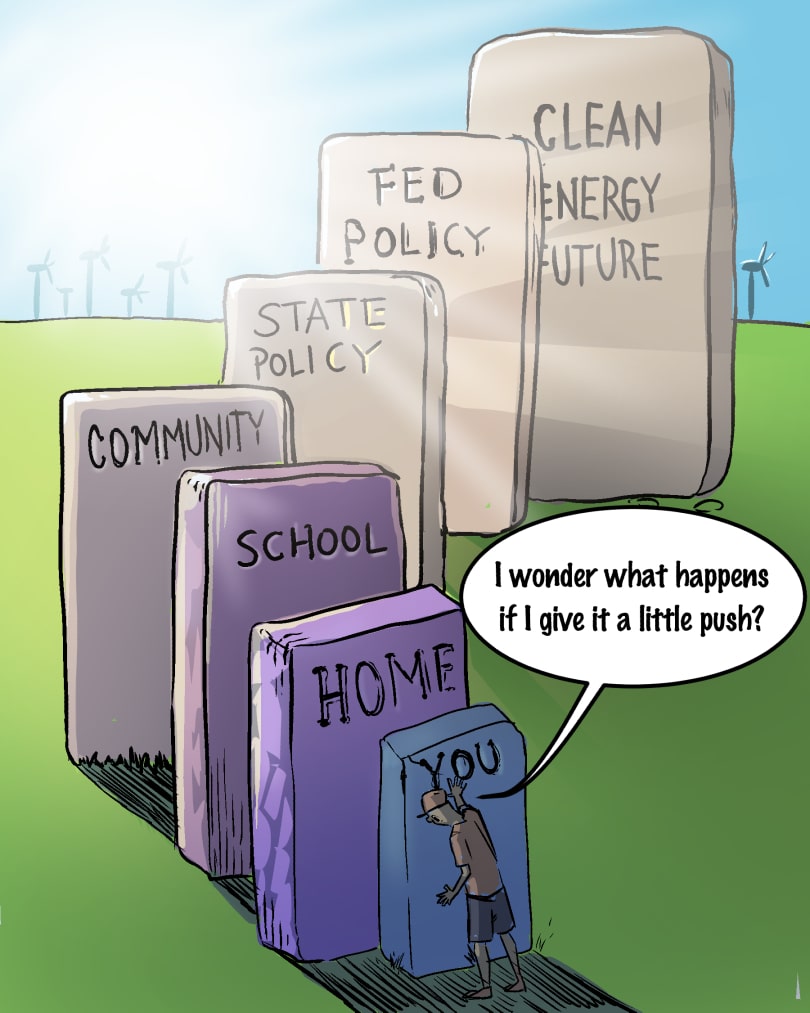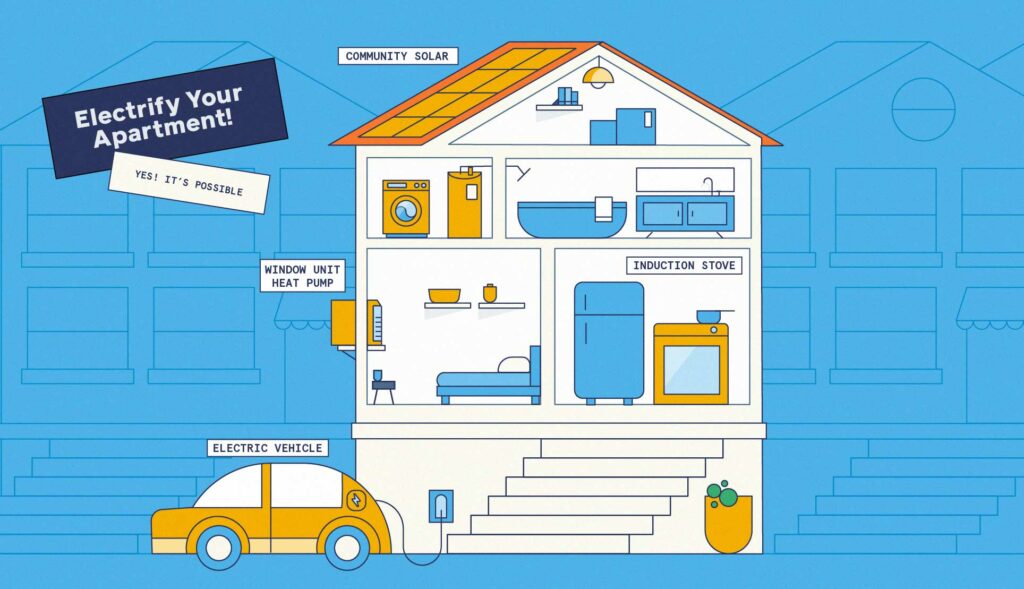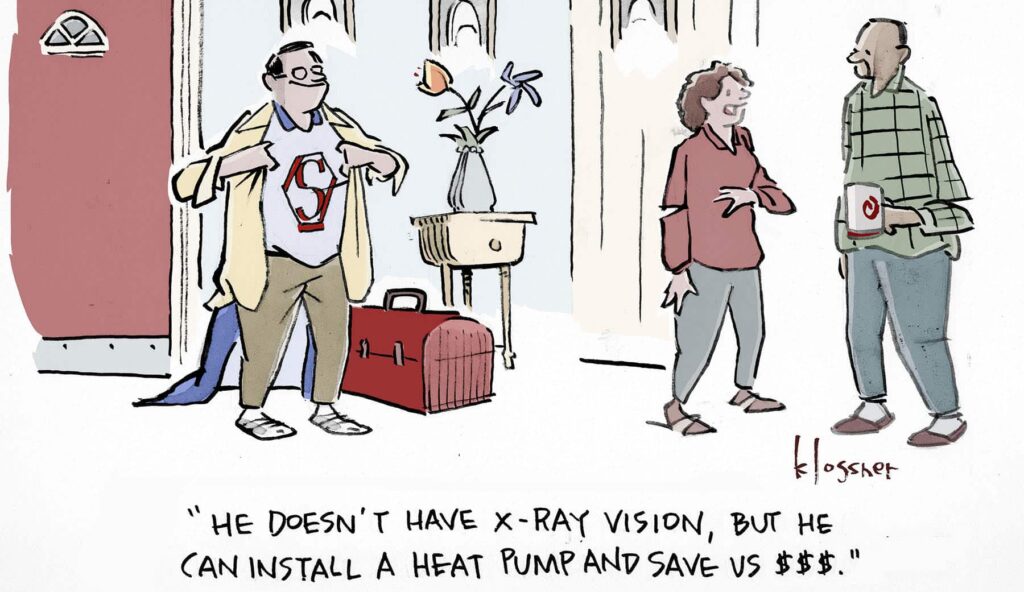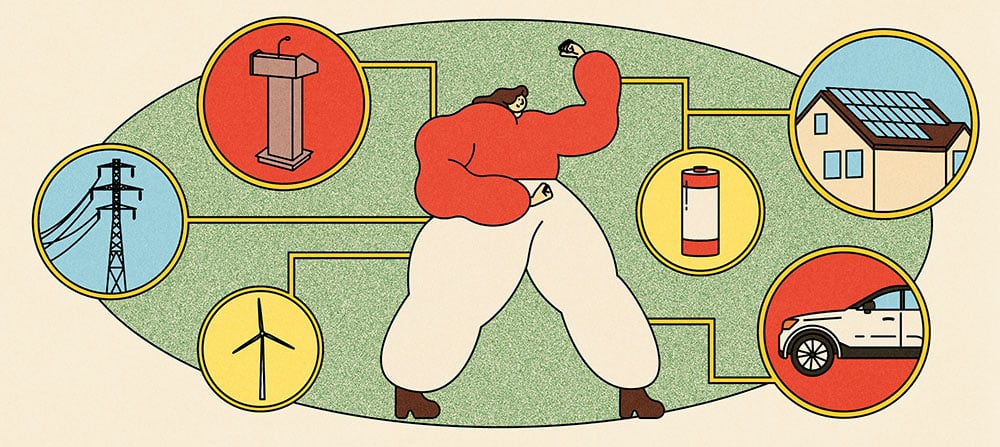Over the past few decades, climate modelers have been busy tinkering with their datasets and scenarios to try to make sense of where we’re headed. For the most part, it looks daunting – greenhouse gas emissions continue to rise, and at the current rate we’re unlikely to be able to keep global warming below 1.5 degrees Celsius this century (the stretch goal of the Paris Agreement). But most climate models are telling only part of the story – and that’s actually a good thing, especially for those of us who want to make a real difference on climate and clean energy.
Current modeling relies on a few key solution areas when developing pathways for how we might (collectively) avoid the most devastating impacts of a heated planet. Most of these scenarios hinge on the critical role of “supply-side” technologies to bring down emissions – things like ramping up wind and solar power, finding more efficient ways to heat and cool buildings, and shifting to low-carbon ways of getting around, like electric vehicles. These are all good things, of course. (Some models also consider options like removing carbon from the atmosphere, which is less proven and more controversial.)
Fossil fuel companies (rightfully) get the lion’s share of the blame for the crisis we find ourselves in. They have rigged the energy and political system for years — including bold-faced lying to Congress for decades and showing no signs of stopping. However, our individual lifestyle choices have also contributed to this mess. With all the focus on techno-solutions, models overlook this key variable: us. Or more specifically, human choices and behavior.
In part, it’s our activities and lifestyles – and the infrastructure and systems that we’ve developed to support them – that contribute to carbon emissions. We need to hold fossil fuel companies accountable for their actions, but it turns out that individuals can have an outsized impact in being part of the solution.
Our hidden human potential
A quick glance at the data reveals what’s at stake here. Studies show that around two-thirds of global greenhouse gas emissions are linked to household consumption – by our rapacious demand for everything from energy to the latest iPhone, from burgers to… all the rest. So while we unquestionably need to adopt new clean tech that will enable us to keep fossil fuels in the ground, changing how we live (i.e., our behavior) is also crucial. What we eat, where we live, how we travel, and what we do for fun all have an impact on our planet. And all of these individual choices add up — far more than we think. According to the United Nations, to achieve the goal of keeping global warming below 1.5 degrees Celsius, each person on Earth, on average, would need to be emitting around 2.5 tons of carbon dioxide a year by 2030, and only 0.7 tons by 2050. For comparison, the average American emits 16 tons annually, one of the highest rates in the world. Getting to a climate-compatible future would require reducing U.S. lifestyle emissions more than 90 percent.
Getting to a climate-compatible future would require reducing U.S. lifestyle emissions more than 90 percent.
Fortunately, our daily activities and choices are also our secret emissions-fighting weapon. Studies show that, individually, we can make the biggest difference on climate by cutting our emissions in food, housing, and transport – transitioning to plant-based diets, adopting clean energy by installing solar or participating in community solar programs, and choosing alternatives to personal car use and frequent flying. As individuals – and collectively, as families, neighborhoods, and societies — we can make decisions overnight to change our behavior – for example, to stop eating beef or to take a bus or train instead of a plane. Often, this can have quicker results than, say, waiting for our local electricity system to transition to renewables (which of course also needs to happen).
Shifting the narrative
In taking climate action, we need to operate on multiple fronts, recognizing that while we have impacts as individuals, our decisions are also constrained by the systems that surround us. That’s why we need all hands on deck: we’ll have to shift our lifestyles as well as the systems that normalize how we live. But advocating for behavioral change is tricky: nobody wants to tell people what to do. So it’s no surprise that modelers, policymakers, and even environmental groups have tiptoed around lifestyle interventions as a climate solution.
The thing is, we’ve been telling the story all wrong. Living more sustainable lives isn’t necessarily about “giving up” or “reducing” (unless you own five mega-yachts, but that’s a different story). It’s about finding opportunities for all of us to meet our needs and live healthy and happy lives, but in ways that use fewer resources and release fewer emissions. This requires thinking more broadly about our ways of living and asking: how can we enjoy many of the same pleasures and relationships, and feel the same sense of abundance, but with vastly lower carbon footprints?
The good news is that, compared to a decade ago, the narrative is already shifting. Nearly everywhere you look, people are embracing creative new approaches to living sustainably. More than 70 percent of Americans are now interested in buying electric cars (and they’re feeling good about it). This year, the UN is focusing World Environment Day (June 6) on the theme Only One Earth, highlighting the need for “transformative changes – through policies and our choices – towards cleaner, greener lifestyles.”
In even better news, a clean energy lifestyle brings a higher quality of life. The reduced pollution, cheaper prices, and better experience of clean energy all improve our lives in tangible ways.
Tweaking the models
Which brings us to why – just maybe – we can start to be more optimistic about climate modeling. Because modelers haven’t been telling the full story about the role of human behavior in shaping emissions, there’s a lot of potential for tweaking – potentially radically adjusting – our scenarios, to get to more informed (and perhaps more hopeful) outcomes. Rapid change in human behavior isn’t just possible, it can have real, measurable impacts – we only have to look back to the Covid-19 lockdowns for proof that behavior change (like driving less), at a massive scale and in a short time period, can lead to a dramatic drop in emissions. Popular lifestyle changes, like adopting an electric vehicle or rooftop solar, can go viral quickly as people influence family, friends, and peers to make the switch.
We only have to look back to the Covid-19 lockdowns for proof that behavior change (like driving less), at a massive scale and in a short time period, can lead to a dramatic drop in emissions.
Studies affirm this. For example, researchers with the University of California at Davis recently tweaked their modeling to explore how evolving social norms and behaviors could lead to potential tipping points in the uptake of clean energy, thereby accelerating emission cuts and changing the global emissions trajectory. Of the 100,000 possible futures generated in the model, nearly a third showed emissions falling rapidly due to positive feedback loops linked to human behavior, resulting in warming of only 1.8°C by 2100 – close to the targeted 1.5°C, even without the use of carbon removal technology. Overall, the study finds that by considering social factors, global warming could be around 0.5 degrees Celsius lower by 2100 compared with what was predicted following last year’s UN climate summit.
Encouragingly, the latest report from the Intergovernmental Panel on Climate Change, released in early April, gives unprecedented coverage to the role of cultural and lifestyle change in reducing emissions, noting that incorporating human behavior into climate models “will expand and improve long-term mitigation scenarios.” The IPCC report highlights the value of modeling “low energy demand” scenarios that factor in more efficient resource use and adjustments in people’s consumption patterns, such as shorter showers, lower heating settings, reduced appliance use, teleworking, avoiding travel, shifts to public transit, uptake of less meat-intensive diets, and reducing food waste. Such interventions could result in additional gigaton-scale emission savings – “beyond the savings achieved in traditional technology-centric mitigation scenarios” – and at lower overall costs.
Given the IPCC findings that lifestyle choices — when adopted at large — can make significant impact in reducing global emissions, and the UC Davis findings that individuals — when acting communally — can instate positive feedback loops that convince others to adopt these lifestyle changes, it is clear that individual actions matter — a lot. Your sphere of influence is larger than you think it is, and when your actions help inspire collective action, bigger pieces fall into place—both politically and in your local community. Alice Larkin of the University of Manchester’s Tyndall Centre for Climate Change Research says “while governments do need to take tough action, they derive their courage to do so from the conduct of citizens.”

Lifestyle interventions aren’t just “another area to consider” in addressing the climate crisis. They’re critical to advancing our climate and sustainability goals — here’s the kicker: in combination with structural changes and political action that enable us to make low-carbon choices.
So yes, there is a (really big) role for individuals to play in the climate and clean energy movement. In fact we need individuals to adopt a lifestyle that aligns with their values and then talk about it — to their friends, families, employers, and legislators. We need a secret weapon in the fight against climate change, and it turns out it’s the person reading this.















